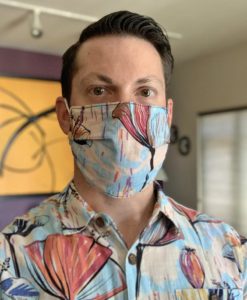By Jonathan Schuppert, AICP, May 13, 2020
 Playgrounds and benches are roped off. Cars during rush hour on freeways “rush” without traffic jams. Parking garages sit empty and parking meters are moneyless. Meanwhile, people are getting pushed out of crowded parks and are starting to take over streets once dominated by automobiles.
Playgrounds and benches are roped off. Cars during rush hour on freeways “rush” without traffic jams. Parking garages sit empty and parking meters are moneyless. Meanwhile, people are getting pushed out of crowded parks and are starting to take over streets once dominated by automobiles.
People seem genuinely happier on the streets now than they were a few months ago.
Lately, I’ve enjoyed long bike rides, my dog in tow, in our refreshingly clean air, great spring weather, and nearly car-free streets. I cross streets without having to press a button, and jog in an empty roadway lane without worrying about twisting my ankle on all the curb ramps I’d encounter on sidewalks. I can avoid the “door zone” (where most bicyclists are forced to ride) and I no longer need to limit my route to neighborhood streets and streets with bike lanes, giving me the freedom I would normally have in a car.
My first full day of married life was largely spent biking around the streets of San Jose at Viva CalleSJ, one of the many great open streets events that take place across the globe. These events “open” the streets to people to walk, run, or roll around, exploring neighborhoods and businesses that people whiz by in cars most of the time. These events celebrate our culture, encourage healthy lifestyles, and rethink the way we plan for public spaces.
While these events are usually temporary, some become more permanent. San Francisco has for years opened large sections of streets in Golden Gate Park to people (not cars) on weekends. Several cities (San Francisco included) have established “slow streets” to better encourage social distancing during this pandemic. And the City of Seattle plans to close 20 miles of streets permanently to most vehicular traffic so people can stay healthy.
As people embrace car-free or car-light lifestyles, what changes will we make to streets — our largest public spaces — to accommodate people and promote health? What aspects of our current environment will extend post-COVID, and how will we view our streets once we slowly stop the distancing? What will plazas and parks look like in the future, and will they be seamlessly connected to “healthy” or “complete” streets around them?
As you travel the streets and experience other public spaces in your city, think about what changes you want to see to promote staying active, keeping social distance, and creating community. I envision wider sidewalks with level street crossings, slower-speed streets where bikes and cars can safely commingle, and additional landscaping for more shade and fresh air.
Welcome, new planners!
As we enter graduation season, I offer a warm welcome to our new planners and encourage them to hold their heads high. I can only imagine their concerns as they enter our profession during an economic downturn and global pandemic. With a tighter job market, new challenges interviewing and onboarding remotely, and an uncertain outcome, this can be a stressful time. It can also be a time of opportunity as the planning world faces our current and future challenges.
What skills will these eager new planners bring to our profession? I hope we can learn from their experience, growing up in a digital age and fluent in asynchronous communication — something we all appear to be practicing in our readjusted schedules.

